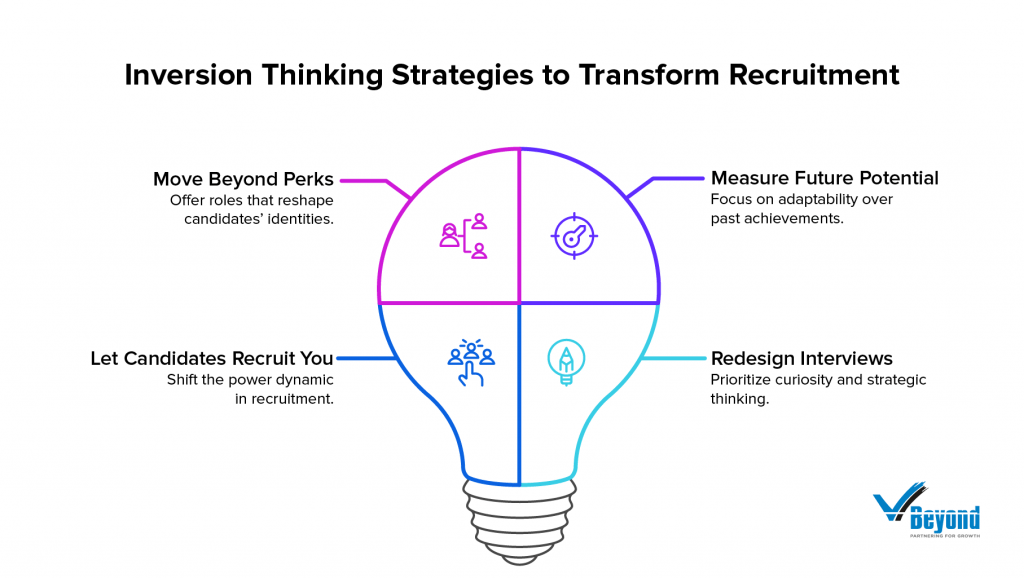Charlie Munger once famously remarked, “All I want to know is where I’m going to die, so I’ll never go there.” It sounds simple, but this principle of avoiding failure rather than seeking success has guided leaders like Munger, Bezos, and Musk in their decision-making. Instead of asking, “How do I succeed?”, they focus on a different question: “What leads to failure?”
Inversion of thinking is powerful, counterintuitive, and the key to a transformativerecruitment strategy and experience. Incidentally, it’s the one recruitment leaders often overlook. In the race to hire the best talent, most companies are asking, “How do we attract the best candidates?” when perhaps the more revealing question is, “Why wouldn’t the best candidates want to work here?” This subtle shift forces us to confront uncomfortable truths. If we don’t scrutinize what drives talent away, we’re missing a chance to rethink recruitment from the ground up.
Most businesses focus their recruitment strategy on selling their strengths, benefits, and perks. But this approach doesn’t uncover the root causes of failure in recruitment—those unseen barriers that could be quietly pushing away top-tier candidates. When we avoid asking difficult questions like “Why would someone turn down this job?”, we miss the chance to address core issues and rethink recruitment at its foundation.
Inversion thinking has long helped visionary leaders avoid pitfalls. When applied to recruitment strategy,, it challenges us to go beyond reactive hiring practices and think critically about the future needs of both our business and creating a future-ready workforce. The goal is no longer to fill open roles, but to anticipate challenges ahead and hire for them.
Why isn’t this happening more often? Because recruitment, like many business processes, tends to rely on tradition and incremental improvements. Companies focus on tweaking existing systems rather than overhauling them. But inversion thinking demands something deeper: it requires flipping the entire approach on its head and scrutinizing not just what works but what fundamentally doesn’t.

The Recruitment Strategy Challenge: Moving Beyond Perks to Identity-Shaping Roles
Too often, the value proposition offered to candidates in creative hiring strategies centers around growth, perks, and stability. But the real question should be, “What if the candidate is rejecting us because the role won’t challenge them enough?” Top talent isn’t just looking for career growth—they’re looking for roles that fundamentally reshape who they are. They’re not satisfied with incremental growth. They want a professional challenge that pushes them into new territory, both intellectually and personally.
This idea of identity-shaping roles is often undervalued in recruitment strategy. We tend to think of job offers in transactional terms: candidates give their skills, and companies give back compensation, benefits, and career progression. But for top-tier candidates, the decision-making process isn’t that simple. The question they’re asking themselves is not just, “What will I gain?” but “Who will I become?”
Here’s the crux: The fear among top candidates isn’t stagnation in the traditional sense—it’s becoming too comfortable, too predictable. They want to know how the role will challenge their assumptions, force them to think differently, and fundamentally alter their approach to their work. The fear of career stagnation doesn’t come from a lack of opportunities, but from the idea that those opportunities might not push them far enough.
This has profound implications for recruitment. Instead of focusing on selling security and growth, companies should be positioning their roles as transformative experiences. The talent that drives innovation wants to work on problems that are difficult, undefined, and messy. They’re looking for roles that push them into areas where they don’t have all the answers, where they’re forced to evolve beyond what they currently know.
Inversion Thinking Applied
- Challenge Over Comfort:
Rather than offering security, offer a challenge when rethinking recruitment. Position the role as one that tests their resilience and forces them into unexplored areas. The message should be simple: “You won’t just grow here—you’ll have to think differently, every day.”
This isn’t just a shift in messaging; it’s a shift in mindset. Companies need to move away from the idea that they are providing candidates with a comfortable, well-structured career path. Instead, they should be selling the idea of discomfort—the discomfort that comes from tackling problems that don’t have clear answers, from working on projects that require constant adaptation.
- Example: “This isn’t a role for those seeking comfort. It’s for those ready to take on problems the industry hasn’t solved yet.”
The importance of positioning your roles as challenges cannot be overstated. When candidates see the role as a stepping-stone, they may take it for short-term advancement. But when they see it as an opportunity to stretch their own potential and solve complex, high-stakes problems, the motivation becomes intrinsic and far more powerful. Top talent particularly thrives when they are challenging their comfort zones, facing problems that push them beyond the familiar.
- Solve Problems That Haven’t Been Solved:
Frame your company as the place where they can lead projects with no clear answers. Top talent doesn’t just want to execute—they want to define what’s next.
- Example: “Join us to tackle questions the market isn’t answering yet—your work here will define the next decade of solutions.”
This resonates with ambitious individuals who crave novelty, complexity, and autonomy. The problems that haven’t been solved yet are far more enticing than the ones that simply need to be managed. By framing your opportunities in this way, you’re positioning your company as a space for creative minds to thrive.
- Candidate Identity Shift as the Outcome:
Recruitment transformation entails going beyond titles and promotions. Ask yourself: “How will this role change the candidate’s professional identity?” How will it push them to evolve into something new, not just better?
- Example: “This role isn’t about where you are today; it’s about who you’ll become after tackling challenges that redefine your expertise.”
In creating a future-ready workforce, the focus should not be on short-term growth but on long-term transformation. By offering roles that force top talent to confront their limits and grow beyond them, you attract those who aren’t just looking for the next step in their career but for the next leap in their development. This is especially important for high-performing individuals who thrive on self-actualization and reinvention.

Measuring What Matters for the Future
Most recruitment processes are backward-looking. We rely on resumes, degrees, and past performance metrics to predict future success. But in fast-evolving industries, past performance is an increasingly unreliable indicator of future potential. Inversion thinking challenges us to ask, “What if the data we’re relying on is irrelevant to the challenges of tomorrow?”
Here’s the thing: traditional recruitment metrics may fall short, but adaptive hiring strategies that test creativity and resilience are better suited for unpredictable future demands. What’s truly valuable is not what candidates have already accomplished, but how they think, adapt, and innovate. It’s about future-facing skills—the ability to respond to unknown challenges, to navigate ambiguity, and to thrive in uncertainty. This is the key to building a future-ready workforce.
Inversion Thinking Applied
- Create Future-Focused Assessments:
Instead of evaluating past KPIs, create tasks that require candidates to solve hypothetical problems your company might face in five years. This kind of exercise will tell you more about their thinking and adaptability than a resume ever could.
- Example: A tech company could ask candidates to design an AI system that adapts to unpredictable ethical standards across multiple countries. This kind of task forces them to show creativity and resilience.
This approach to recruitment doesn’t just measure technical skills or past accomplishments—it measures the qualities that will drive success in an uncertain future. It’s about identifying who can create value in contexts that don’t yet exist.
- Track Unconventional Metrics:
Move away from static resumes and consider unconventional indicators—like how someone integrates emerging technologies or adapts to unexpected challenges. These traits are more predictive of future success than a list of past accomplishments.
- Example: Instead of a traditional interview for a product development role, give candidates the framework of an unsolved product challenge. Watch how they approach the unknown, gather insights, and iterate on their ideas. This shows how they think and adapt under pressure, something no degree or resume can fully convey.
In this sense, recruitment becomes about identifying potential rather than proving experience. By focusing on adaptability, resilience, and innovation, companies can attract candidates who will continue to add value even as industries, markets, and technologies evolve.

Turning the Tables: What If the Candidate Was Recruiting You?
Traditionally, companies hold all the cards in recruitment. Candidates apply, jump through hoops, and prove their worth. But what if we flipped the script? What if we approached the process as if top candidates were recruiting us?
In a competitive market, the balance of power has shifted. Top-tier candidates are often juggling multiple offers. It’s no longer enough to post a job and wait for them to come to you. Companies must take a more active approach in convincing candidates that their company is the one worth choosing.
But convincing these candidates takes more than perks or prestige—it’s about positioning your company as the one that offers them the most meaningful, challenging, and transformative work. What if, instead of evaluating candidates, we let them evaluate us?
Inversion Thinking Applied
- Personalized Case Studies:
Instead of generic job descriptions, send top candidates a personalized outreach. Show them, through specific examples, how they can make an impact—how their role will look and what their work will achieve.
- Example: “Here’s what your first year could look like leading this new product line, with milestones you’ll create and a team you’ll shape.”
By providing a detailed vision of what the candidate’s work would look like, you’re giving them a real sense of ownership over the projects they would be leading. This approach builds a stronger connection between the candidate and the company and shows them that the company has invested in their individual potential.
- Micro-Experiences:
Don’t limit the recruitment process to interviews. Offer candidates a chance to work on a short-term project or collaborate on a problem your company is facing. Let them experience firsthand what it’s like to work with your team.
- Example: A biotech firm could invite top scientists to a week-long collaborative research sprint. By the end, both the company and the candidate will know whether they’re a good fit for each other.
This goes beyond the typical hiring process. It allows both the company and the candidate to get a real sense of fit before making any long-term commitments. By flipping the power dynamic, you create a mutual decision-making process where the candidate feels empowered to choose you as much as you choose them.

Redesigning the Interview: From Answers to Questions
The typical interview process is structured to test what the candidate knows. But inversion thinking encourages us to evaluate the candidate based on their curiosity, not just their answers. The best candidates won’t just respond to questions—they’ll ask them, diving into the complexity of the company’s biggest challenges.
Curiosity, after all, is what drives innovation. Candidates who ask questions are the ones who think critically, who aren’t satisfied with the status quo, and who are willing to challenge conventional thinking. These are the qualities that will set them apart in a world where problems are rarely straightforward.
Inversion Thinking Applied
- Let the Gaps Speak:
Don’t over-prepare for interviews. Instead, present candidates with complex, unsolved challenges your company is facing, and leave some gaps in the information. Pay attention to the questions they ask and how they approach the unknown. This reveals far more about their strategic thinking than rehearsed answers ever could.
- Example: Introduce an unresolved leadership debate. Observe how the candidate reacts and whether they ask probing questions about how the leadership team navigates uncertainty.
- Offer Fragments, Not Full Stories:
Provide candidates with pieces of information rather than neat narratives. This forces them to engage actively, filling in the blanks with their own insights and curiosity.
- Example: Give a high-level overview of a project but leave out key parts of the decision-making process. Watch how the candidate tries to piece the story together—this shows their engagement and ability to think critically.


Conclusion: Inversion Thinking as the Future of Recruitment
Inversion thinking as a future recruitment trend isn’t just a mental exercise—it’s a strategy that can reshape recruitment. The companies that embrace this mindset will be the ones that don’t just fill roles but build visionary teams capable of navigating the unknown. Instead of focusing on what’s familiar and comfortable, they’ll push candidates—and themselves—to redefine what’s possible.
The talent that seeks more than a job is out there. They want to solve unsolved problems, challenge their own assumptions, and reshape industries. The question is, are you ready to meet them on those terms?
Looking to build a future-ready workforce that thrives on innovation and adaptability? Partner with us for transformative recruitment solutions that push beyond the ordinary, attracting top talent ready to redefine your industry.


